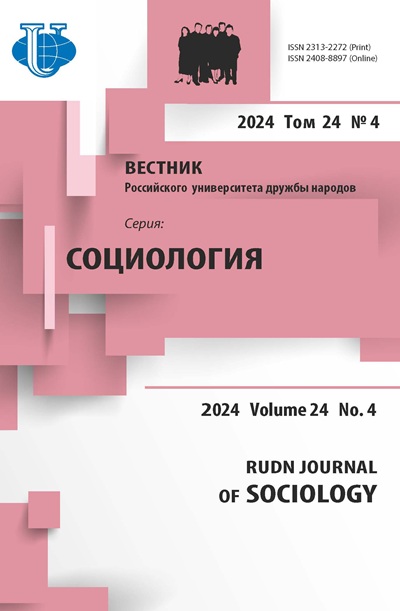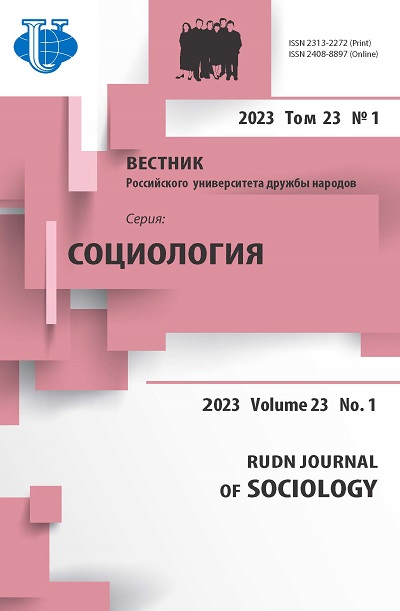Воспроизводство и изменение дискурсов культуры коренных народов: этнографические самоописания кольских саамов
- Авторы: Куропятник М.С.1
-
Учреждения:
- Санкт-Петербургский государственный университет
- Выпуск: Том 23, № 1 (2023)
- Страницы: 26-39
- Раздел: Вопросы истории, теории и методологии
- URL: https://journals.rudn.ru/sociology/article/view/33926
- DOI: https://doi.org/10.22363/2313-2272-2023-23-1-26-39
Цитировать
Полный текст
Аннотация
В статье этнографическое самоописание рассматривается как культурная форма, в которой индигенные авторы концептуализируют свою культуру в смещающихся социальных контекстах. Этнографические самоописания подразумевают: (а) трансформацию коренными народами устно-дискурсивного опыта своей культуры в текст; (б) интерпретации научных версий культуры индигенными авторами. Вопрос заключается в том, как саамская культура концептуализируется в тексте и как письменный текст - саамскими авторами, принимающими во внимание как научные описания своей культуры, так и недискурсивные культурные формы (этнографические коллекции)? В текстах индигенных авторов антропологические версии культуры могут выступать источником воспроизводства некоторых паттернов концептуализации их культуры, релевантных ряду подходов в социальных науках. Этнографические самоописания интерпретируются автором в терминах интертекстуальности, при этом в фокусе внимания - отношения между устным и письменным, академическим и индигенным дискурсом, а также между дискурсивными и недискурсивными практиками. Тексты как часть культурной реальности и как элемент социальных событий имеют каузальный эффект, способствуя изменению видения и способов репрезентации саамской культуры с точки зрения коренных народов. Таким образом, они вовлечены в воспроизводство, создание и модификацию множественных дискурсов саамской культуры. В процессе самоописания «культура» может быть реконтекстуализирована акторами. При этом позиции и идентичность наблюдателя (автора) и коренного народа, чья культура выступает объектом описания, связаны множественными частичными отношениями, что подразумевает изменение эпистемологического статуса индигенного дискурса. Процессуальный подход к концептуализации культуры и фокус на точке зрения коренных народов, представленной в этнографических самоописаниях, составляют методологическую основу изучения ряда культурных тенденций у кольских саамов (Россия). В статье анализируются опубликованные тексты саамских авторов, не являющихся профессиональными антропологами.
Ключевые слова
Об авторах
Марина Степановна Куропятник
Санкт-Петербургский государственный университет
Автор, ответственный за переписку.
Email: kuropjatnik@bk.ru
доктор социологических наук, заведующая кафедрой культурной антропологии и этнической социологии Университетская наб., 7-9, Санкт-Петербург, 199034, Россия
Список литературы
- Afanaseva N. The current state of the Sámi language. Saprykin V.P., Smirnova L.M. (Eds.). Indigenous Peoples of the European Arctic Region. Murmansk; 2012. (In Russ.).
- Afanasieva A. Boarding School Education of the Sámi People in Soviet Union (1935-1989): Experiences of Three Generations. Arctic University of Norway; 2018.
- Allemann L. Yesterday’s memories, today’s discourses: The struggle of the Russian Sámi to construct a meaningful past. Arctic Anthropology. 2017; 54 (1).
- Anuchin D.N.N. Kharuzin’s Russian Lapps. Ethnographic Review. 1890; 4 (1). (In Russ.).
- Barth F. The analysis of culture in complex societies. Ethnos. 1989; 54 (3-4).
- Bjørclund I. Sápmi: Becoming a Nation. The Emergence of a Sámi National Community. Tromsø; 2000.
- Bolshakova N. Life, Customs and Myths of Kola Sámi in the Past and Present. Murmansk; 2005. (In Russ.).
- de Castro E.V., Goldman M., Lebner A. Slow motions. Comments on a few texts by Marilyn Strathern. Cambridge Journal of Anthropology. 2008-2009; 28 (3).
- Charnolusky V.V. In the Land of the Flying Stone. Moscow; 1972. (In Russ.).
- Clifford J. On ethnographic allegory. Clifford J., Marcus G.E. (Eds.). Writing Culture: The Poetics and Politics of Ethnography. Berkeley; 1986.
- Clifford J. Returns: Becoming Indigenous in the Twenty-First Century. Cambridge; 2013.
- Cocq C. Revoicing Sámi Narratives. North Sámi Storytelling at the Turn of the 20th Century. Umeå; 2008.
- Cocq C. Anthropological places, digital spaces and imaginary scapes: Packaging a digital Sámiland. Folklore. 2013; 124 (1).
- Cocq C. Traditionalization for revitalization: Tradition as a concept and practice in contemporary Sámi contexts. Folklore. 2014; 57.
- Collins P., Gallinat A. Introduction. Collins P., Gallinat A. (Eds.). The Ethnographic Self as a Resource: Writing Memory and Experience into Ethnography. New York; 2010.
- Douglas M. Traditional culture - let’s hear no more about it. Rao V., Walton M. (Eds.). Culture and Public Action. Stanford; 2004.
- Dussart F., Poirier S. Knowing and managing the land: The conundrum of coexistence and entanglement. Dussart F., Poirier S. (Eds.). Entangled Territorialities. Negotiating Indigenous Lands in Australia and Canada. Toronto; 2017.
- Fairclough N. Analysing Discourse: Textual Analysis for Social Research. London; 2003.
- Fillitz T., Saris A.J. Introduction: Authenticity aujord’hui. Fillitz T., Saris A.J. (Eds.). Debating Authenticity. Concepts of Modernity in Anthropological Perspective. New York; 2013.
- Handler R. Authenticity. Anthropology Today. 1986; 2 (1).
- Handler R., Linnekin J. Tradition, genuine or spurious. Journal of American Folklore. 1984; 97.
- Junka-Aikio L. Can the Sámi speak now? Deconstructive research ethos and the debate on who is a Sámi in Finland. Cultural Studies. 2016; 30 (2).
- Junka-Aikio L. Institualization, neo-politization and the politics defining Sámi research. Acta Borealia. 2019; 36 (1).
- Kert G.M. (Ed.) Sámi Fairy Tales. Murmansk; 1980. (In Russ.).
- Kharuzin N. Russian Lapps. Essays on the Past and Contemporary Life. Moscow; 1890. (In Russ.).
- Konstantinov Yu. Conversations with Powers: Soviet and Post-Soviet Developments in the Reindeer Husbandry Part of the Kola Peninsula. Uppsala; 2015.
- Konstantinov Yu., Ryzhkova I. ‘Empty space’ vs. ‘full place’: Gender asymmetry as an expression of ‘folk binarism’ in the reindeer husbandry part of the Kola Peninsula (Northwest Russia). Anthropological Forum. 2019; 40. (In Russ.).
- Kuropjatnik M.S. Indigenous peoples in the context of cultural continuity. RUDN Journal of Sociology. 2016; (16) 4. (In Russ.).
- Latour B. We Have Never Been Modern. Essays on Symmetrical Anthropology. SaintPetersburg; 2006. (In Russ.).
- Luhmann N. Self-Descriptions. Moscow; 2009. (In Russ.).
- Mamontova N. Nomadizing in the online space. Representation of the Evenk culture in VKontakte. Siberian Historical Studies. 2014; 2. (In Russ.).
- Mankova P. Heterogeneity and spontaneity: Reindeer races, bureaucratic designs and indigenous transformations at the Festival of the North in Murmansk. Acta Borealia. 2017; 34 (2).
- Mechkina E. Folklore Traditions in the Culture of the Sámi Family. Apatity; 2010. (In Russ.).
- Mironova N.N. Yokanga. Murmansk; 2009. (In Russ.).
- Mironova N.N. Yokanga. Part 2. Murmansk; 2017. (In Russ.).
- Mozolevskaya A., Kulinchenko G. (Eds.) Sámi Costume. Murmansk; 2009. (In Russ.).
- Mozolevskaya A., Mechkina. E. Sámi Patterns. Murmansk; 2011. (In Russ.).
- Narayan K. How native is a ‘native’ anthropologist? American Anthropologist. 1993; 95 (3).
- Nustad K.G. Considering global/local relations: Beyond dualism. Eriksen T.H. (Ed.). Globalization. Studies in Anthropology. London; 2003.
- Peterson N. Is there a role for anthropology in cultural reproduction? Maps, mining and the ‘cultural future’ in Central Australia. Dussart F., Poirier S. (Eds.). Entangled Territorialities. Negotiating Indigenous Lands in Australia and Canada. Toronto; 2017.
- Robbins J. Beyond the suffering subject: Toward an anthropology of the good. Journal of the Royal Anthropological Institute. 2013; 19 (3).
- Sahlins M. Two or three things that I know about culture. Journal of the Royal Anthropological Institute. 1999; 5 (3).
- Strathern M. The limits of auto-anthropology. In: Anthropology at home, ed by Jackson A. London: Tavistock Publications; 1987; p.16-37.
- Strathern M. Foreword. Shifting contexts. Strathern M. (Ed.) Shifting Contexts: Transformations in Anthropological Knowledge. London; 1995.
- Strathern M. Partial Connections. Walnut Creek; 2004.
- Suleymanova O., Patsiya E. Daily and households’ aspects of the adaptation to the urban way of life of the Sami. Proceedings of the Kola Scientific Center of the Russian Academy of Sciences. 2016; 8-10. (In Russ.).
- Thuen T. When cultural idioms ‘freeze’. Some consequences of objectification of Sámi culture. Holtedahl L., Gerard S., Njeuma M.Z., Boutrais J. (Eds.). The Power of Knowledge. From the Arctic to the Tropics. Paris; 1999.
- Thuen T. Culture as property? Some Saami dilemmas. Kasten E. (Ed.). Properties of Culture - Culture as Property. Pathways to Reform in Post-Soviet Siberia. Berlin; 2004.
- Thuen T. The concept of indigeneity. Social Anthropology. 2006; 14 (1).
- Trouillot M.R. Global Transformations. Anthropology and the Modern World. New York; 2003.
- Turi J. Muittalus Samid Birra. Stockholm; 1910.
- Turner T. Anthropology and multiculturalism: What is anthropology that multiculturalists should be mindful of it? Cultural Anthropology. 1993; 8 (4).
- Vladimirova V. Transnational indigenous structures, liberal multiculturalism, and narratives of ‘indigenous separatism’ in Russia’s North. Siberian Historical Studies. 2015; 1. (In Russ.).
- Yakovleva E. Sámi National Day - February 6. Saprykin V.P, Smirnova L.M. (Eds.). Indigenous Peoples of the European Arctic Region. Murmansk; 2012. (In Russ.).














